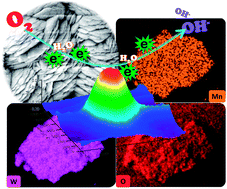Tuning the MnWO4 morphology and its electrocatalytic activity towards oxygen reduction reaction†
Abstract
The present study explores the morphological evolution and structure–activity correlation of manganese tungstate (MnWO4), a new electrocatalyst towards alkaline oxygen reduction reaction (ORR). Morphological tuning was performed by a complexation–precipitation approach employing one-pot hydrothermal synthesis and the obtained material was characterized using XRD, FT-IR and XPS. A peculiar bird-feather (BF) like morphology was obtained by optimizing the structure directing agent (SDA) concentration, reaction temperature and time. Its ORR reactivity was studied by performing macro and micro-electrochemical analysis suggesting a prominent (2 + 2) e− pathway having an onset potential of 0.99 V (vs. RHE). Furthermore, the role of the SDA in generating electrocatalytically active sites was mapped by performing comparative scanning electrochemical microscopy imaging (SECM) in the redox-competition (RC) mode. The obtained surface plots correlated well with the rotating ring-disk electrode (RRDE) measurements in response to distinct sample (MnWO4) potentials ranging from kinetic-limited to mass-transfer limited domains. The morphologically optimized MnWO4 was further found to be an efficient electrocatalytic competitor against Pt/C (20%), an expensive and limited noble-metal catalyst.



 Please wait while we load your content...
Please wait while we load your content...